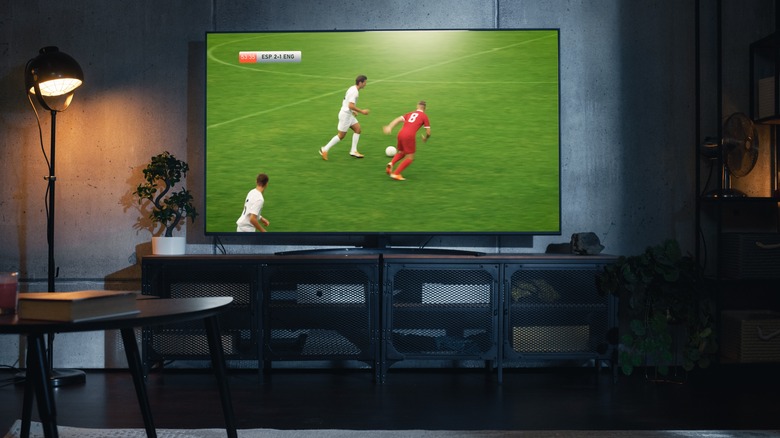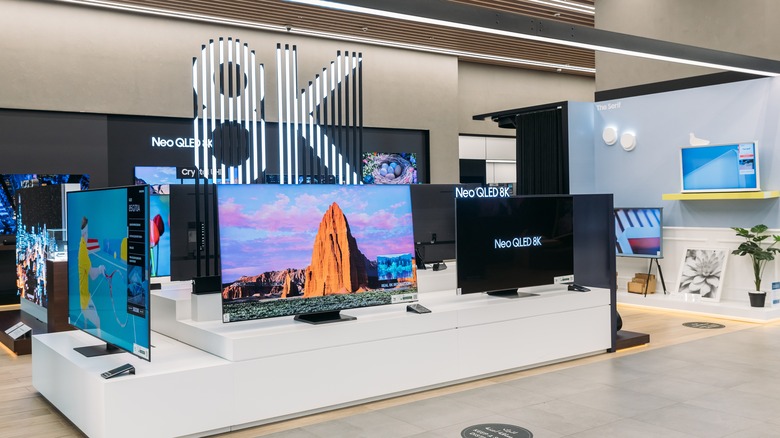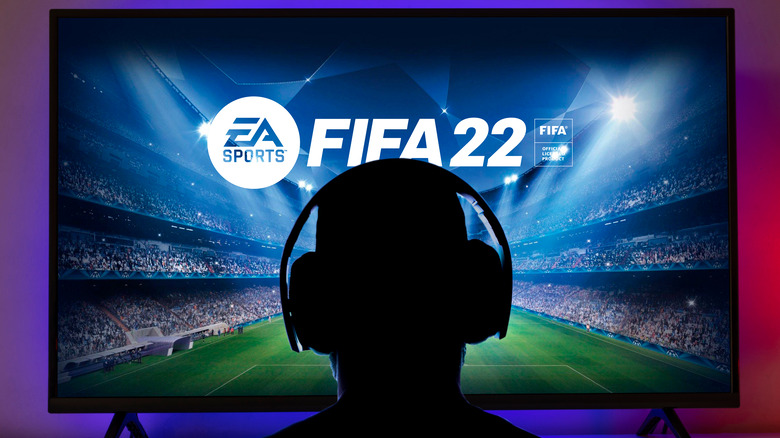Refresh Rate Vs. Motion Rate: How TV Brands Fudge The Numbers
Nowadays, buying a TV or a monitor may seem easy, but it isn't. Not only are there a ton of models with varying specifications available, but there is also some deliberate confusion being created by TV manufacturers due to the marketing jargon getting in the way of standardized technological specifications.
The most important example of this is the sheer amount of numbers you need to pay attention to while buying a TV. To begin with, there's the resolution, which has largely been confusion-free, at least for TVs. That means you know exactly what resolution you're getting when buying a Full HD, 4K, or 8K TV. For monitors, resolutions vary far and wide, but you can still look for that specification and easily decode the actual number.
The next most important figure is the refresh rate, which is where mass confusion begins. Over the years, TV brands have started to fudge the refresh rate numbers and confuse buyers by cross-marketing them with the motion rate. Most buyers don't realize that the refresh rate and the motion rate are two different things. Here's how the two are different and everything you need to know about the refresh rate vs. motion rate debate before you buy a TV.
What is refresh rate?
The whole confusion begins with the refresh rate, which is an important metric that is misunderstood and misrepresented. The refresh rate is a key parameter of every display. Simply put, it is the number that denotes how many times a second a screen refreshes to display a moving image. To display a moving image, a display needs to draw a new image very quickly, and the refresh rate is the frequency at which the screen can display a new image (via Intel).
Refresh rate is measured in hertz (Hz) since it's a frequency number relating to the number of refreshes per second. The higher the refresh rate of a display is, the quicker it will be able to draw the next frame, making the picture appear smoother.
There are a wide variety of refresh rates available on displays today, making it the second most important metric to look out for. If you're looking for a gaming TV or monitor, the higher the refresh rate, the better, provided your connected PC or console can support the output. For general purposes, that isn't quite the rule to follow, and it depends upon the frame rates of the content you plan to play on your TV.
What is frame rate?
Refresh rate is how quickly a display can refresh to display a moving image. However, to be able to take full advantage of this refresh rate, you need the content to have a frame rate that is close to the refresh rate. Basically, whatever moving image you display on the screen will have a frequency at which it displays a new image. These images are called frames, and the frequency with which these images appear in a second is called the frame rate (via TechSmith). It's measured in frames per second, or fps.
But wait: Refresh rate and frame rate are both frequencies of images displayed in a second, so what is the difference between the two? The refresh rate is a hardware specification, meaning your TV or monitor's display panel needs to support it. On the other hand, the frame rate is an attribute of the content you'll play, like a video file or a game. Of course, for games, the frame rate will depend upon the hardware power of your computer or gaming console. It depends on the computer's hardware and not the monitor or TV connected to the computer or the console.
So if you want to play a high fps video file, the video file will need to have a high frame rate. If you want to play a game at a high frame rate, you will need to have a PC or console capable of running it at high fps and supporting the appropriate display output. And in addition, you will need a TV or monitor with a high refresh rate to be able to see the high fps content properly.
What is motion rate?
Refresh rates and frame rates are generally simple concepts. The confusion that occurs with regard to these specifications is because of something called the motion rate. Motion rate is a common feature that goes by a lot of different names because every brand has a different name for this feature. RTINGS.com very accurately calls motion rate "fake refresh rate" because that's what it is, in essence.
Motion rate is nothing but a software enhancement that uses various techniques to fake the refresh rate of the TV. When motion rate enhancements are enabled, the end result is a smoother-looking picture with a very characteristic and faux look that is discernable from an actual high refresh rate TV, often called the motion smoothing effect. At the same time, it may be an acceptable middle-ground for users that want a smoother picture without having to spend more for the hardware capabilities.
These fake refresh rates are advertised under different names by different brands and are usually marketed in a manner that will make the average buyer think that they're looking at a hardware-supported refresh rate figure. The motion rate is pretty much always a multiple of the actual refresh rate of the display, often 2x, 4x, or even 8x. Here are the common brand names for the same:
-
Hisense — Motion Rate, 2x or 4x the actual refresh rate
-
LG — TruMotion, 2x the actual refresh rate
-
Samsung — Motion Rate/Clear Motion Rate, 2x the actual refresh rate
-
Sony — Motionflow XR/X-Motion Clarity, 4x or 8x the actual refresh rate
-
TCL — Clear Motion Index (CMI)/Natural Motion, 4x the actual refresh rate
-
Vizio — Clear Action/Dynamic Motion Rate, 2x the actual refresh rate
Motion interpolation, MEMC, and black frame insertion explained
Now that we've discussed motion rate and the different names used by TV manufacturers for it, let's understand how these technologies work. Most motion smoothing is done by using motion interpolation, a method used to add more frames to give an apparently smoother image output. We see two main technologies used for motion smoothing, which TV manufacturers then try to bundle under the different names discussed above.
MEMC — Short for motion estimation and motion compensation. This is a common motion interpolation technology when it comes to motion smoothing implementations in TVs. MEMC works by estimating motion by looking at the motion vectors and the direction in which objects are moving. As this IEEE paper on MEMC explains, it calculates the motion trajectory and adds a frame before the next frame appears, acting like an artificial bridge between the two frames. Some implementations may also use AI to generate the next frame. This results in a smooth motion, which gives it a high-refresh-rate look, but may bring in additional display artifacts which defeat the purpose.
Black Frame Insertion — This is used to counter motion blur, often in scenarios where motion smoothing is in progress. Black frame insertion works by inserting a black frame between two frames, either by rapidly turning the backlight on and off, or in the case of OLED displays, rapidly turning the screen on and off, as How-To Geek explains. This gives the image a smoother look. BFI is generally used to get a smoother motion output without the typical motion smoothing effect.
Refresh rate vs. motion rate
Refresh rate and motion rate will both give you a smoother picture, but not quite the same way. Refresh rate is a hardware property, which means that you will be able to get a smoother picture on a hardware level, which is superior. Motion rate, on the other hand, is a feature included to combat hardware shortcomings of the TV. When it comes to TVs, the standard refresh rate is 60Hz, and a high refresh rate is generally 120Hz.
Motion rate implementations aim to give you more than what the hardware is capable of. However, the motion rate still often gives a fake soap opera effect when enabled, so it's not equivalent to having a proper high refresh rate TV. Motion rate promises to take 60Hz displays to 120Hz, or even 240Hz and 480Hz, and 120Hz displays to 240Hz, 480Hz, and even 960Hz. However, the TV will still be actually 60Hz or 120Hz, and the motion rate won't quite change that hardware limitation. Knowing this is crucial to understand the confusing jargon manufacturers use to denote motion rate (via DisplayNinja).
As explained earlier, frame rate also plays a crucial part here. While motion rate promises a smoother picture, it can't quite display a higher frame rate as-is. So if you want to play a 120fps clip on a 60Hz TV, or play a game running at 300fps on a 120Hz TV, you won't actually see output above the native refresh rate of the TV (60Hz/120Hz). So even if you're getting a 400fps figure in your game, you'll only see 60fps if your monitor or TV supports a 60Hz refresh rate, even if the motion rate promised by the manufacturer is 480Hz.
How to tell the refresh rate and motion rate of your TV
With the marketing jargon and unnecessary confusion, it has become difficult to tell what refresh rate a TV has. This has made TV purchases more complicated than they should be. However, there are ways to look past misleading marketing to buy the best TV for your use.
The universal advice here would be to always look for the specification, which says "refresh rate." Regardless of whether you're buying a TV in-store, online, or already have a TV, you can check the model number online and find the full specifications on the manufacturer's website. Look for the refresh rate listed under the specifications. That's the only number you should look at, especially if you're trying to buy a TV that has a higher hardware-supported refresh rate. Make sure that the refresh rate specification doesn't say that the refresh rate is with MEMC, since that would mean that it is not the actual refresh rate but instead the motion rate.
You should also watch out for manufacturer branding around the refresh rate figure. Make sure the refresh rate figure isn't clubbed together with any of these words: Motion Rate, TruMotion, Motionflow XR, X-Motion Clarity, Natural Motion, Clear Motion Index (CMI), Clear Action, or Dynamic Motion Rate. Any such non-standard branding indicates a different term for motion rate, and not the actual refresh rate (per Tom's Guide).
How to buy the right TV with the right refresh rate for your needs
What refresh rate your TV needs is rather subjective. While higher refresh rates are great to have, they will also cost more given how they have more capable hardware inside, as Reviewed points out. In the end, however, it will depend on what you plan to use your TV for, and it makes little sense to overspend on a TV with a higher refresh rate if you're not going to make use of it.
For example, nearly all TV content and movies are limited to 24fps, and a few ones, called high frame rate (HFR), are limited to 48fps. Most broadcast/streaming TV content also sticks to these numbers. Even YouTube currently only goes to 60fps at the most. As such, a 60Hz refresh rate will suffice for pretty much all regular TV viewing since you're not going to need or use the higher refresh rate due to the sheer lack of content.
On the other hand, if you're going to be gaming on the TV, and especially if you have a newer console like the Xbox Series X or PlayStation 5, or even a capable PC, you should opt for a TV with a 120Hz refresh rate. TVs generally don't come with a higher refresh rate, so the ideal option for gaming would be a 120Hz refresh rate TV with HDMI 2.1 since DisplayPort isn't a common option on TVs.
Should you use motion rate features?
Pretty much all new TVs, including the best budget 4K TVs, will have some sort of motion-smoothing technology built in, and with AI implementations getting more common, these technologies are improving as well. So if you have a TV with motion rate features, the question is — should you use them?
Well, once again, the answer comes down to preference. Motion rate isn't a bad feature inherently. It has gained a bad rep due to the faux-smoothed look's general distaste, which is called the soap opera effect. The best course here would be to enable the motion smoothing features and see how it looks with your regular viewing. If you like it, as many people do for sports content, you can keep them enabled. If you don't like it, turn it off.
Over the years, we have seen many arguments in support of motion-smoothing features. WIRED argued that you could have a good experience by turning on motion smoothing features if you keep it on the lowest setting. A PCMag opinion piece argued that you should turn on motion smoothing for live sports only and keep it off for other content, which is something a lot of folks do. Then there are folks who hold a strong distaste for motion smoothing and think it should be disabled entirely, as opined in this Vulture piece.
This difference in opinion just strengthens the fact that it boils down to personal preference, so set your TV to whatever setting looks best to you, and enjoy!








